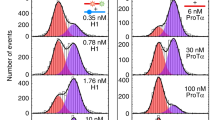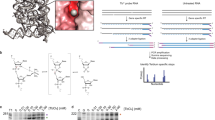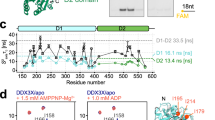Abstract
To visualize the interplay of RNA structural interactions in a ligand binding site, we have determined the solution structure of a high affinity RNA–theophylline complex using NMR spectroscopy. The structure provides insight into the ability of this in vitro selected RNA to discriminate theophylline from the structurally similar molecule caffeine. Numerous RNA structural motifs combine to form a well-ordered binding pocket where an intricate network of hydrogen bonds and stacking interactions lock the theophylline into the complex. Two internal loops interact to form the binding site which consists of a sandwich of three base triples. The complex also contains novel base-zipper and 1-3-2 stacking motifs, in addition to an adenosine platform and a reversed sugar. An important feature of the RNA is that many of the conserved core residues participate in multiple overlapping tertiary interactions. This complex illustrates how interlocking structural motifs can be assembled into a highly specific ligand-binding site that possesses high levels of affinity and molecular discrimination.
This is a preview of subscription content, access via your institution
Access options
Subscribe to this journal
Receive 12 print issues and online access
$259.00 per year
only $21.58 per issue
Buy this article
- Purchase on SpringerLink
- Instant access to full article PDF
Prices may be subject to local taxes which are calculated during checkout
Similar content being viewed by others
References
Tuerk, C. & Gold, L. Systematic evolution of ligands by exponential enrichment: RNA ligands to bacteriophage T4 DMA polymerase. Science 249, 505–510 (1990).
Ellington, A.D. & Szostak, J.W. In vitro selection of RNA molecules that bind specific ligands. Nature 346, 818–822 (1990).
Gold, L., Polisky, B., Uhlenbeck, O. & Yarus, M. Diversity of oligonucleotide functions. Annu. Rev. Biochem. 64, 763–797 (1995).
Lauhon, C.T. & Szostak, J.W. RNA aptamers that bind flavin and nicotinamide factors. J. Am. Chem. Soc. 117, 1246–1257 (1995).
Connell, G.J., Illangesekare, M. & Yarus, M. Three small oligoribonucleotides with specific arginine sites. Biochemistry 32, 5497–5502 (1993).
Sassanfar, M. & Szostak, J.W. An RNA motif that binds ATP. Nature 364, 550–553 (1993).
Wang, Y., Killian, J., Hamasaki, K. & Rando, R.R. RNA molecules that specifically and stoichiometricatly bind aminoglycoside antibiotics with high affinities. Biochemistry 35, 12338–12346 (1996).
Gold, L. Oligonucleotides as research, diagnostic, and therapeutic agents. J. Biol. Chem. 270, 13581–13584 (1995).
Irvine, D., Tuerk, C. & Gold, L. Selexion — systematic evolution of ligands by exponential enrichment with integrated optimization by nonlinear-analysis. J. Mol. Biol. 222, 739–761 (1991).
Jenison, R.D., Gill, S.C., Pardi, A. & Polisky, B. High-resolution molecular discrimination by RNA. Science 263, 1425–1429 (1994).
Milligan, J.F. & Uhlenbeck, O.C. Synthesis of small RNAs using T7 RNA polymerase. Meth. Enz. 180, 51–62 (1989).
Pardi, A. Multidimensional heteronuclear NMR experiments for structure determination of isotopically labeled RNA. Meth. Enz. 261, 350–380 (1995).
Brünger, A.T. X-PLOR 3.1: A System for X-ray Crystallography and NMR (Yale University Press, New Haven, Connecticut; 1992).
Wimberly, B., Varani, G. & Tinoco, I., Jr. The conformation of loop E of eukaryotic 5S ribosomal RNA. Biochemistry 32, 1078–87 (1993).
Szewczak, A.A. & Moore, P.B. The sarcin/ricin loop, a modular RNA. J. Mol. Biol. 247, 81–98 (1995).
Battiste, J.L., Ruoying, T., Frankel, A.D. & Williamson, J.R. Assignment and modeling of the Rev Response Element RNA bound to a Rev peptide using 13C-heteronuclear NMR. J. Biomol. NMR 6, 375–389 (1995).
Cate, J.H. et al. RNA tertiary structure mediation by adenosine platforms. Science 273, 1696–1699 (1996).
Saenger, W. Principles of NucleicAcid Structure (Springer-Verlag, New York; 1984).
Wu, M. & Turner, D.H. Solution structure of (rGCGGACGC)2 by two-dimensional NMR and the iterative relaxation matrix approach. Biochemistry 35, 9677–9689 (1996).
Gehring, K., Leroy, J.L. & Guéron, M. A tetrameric DNA-structure with protonated cytosineṁcytosine base-pairs. Nature 363, 561–565 (1993).
Pley, H.W., Flaherty, K.M. & McKay, D.B. Three-dimensional structure of a hammerhead ribozyme. Nature 372, 68–74 (1994).
Scott, W.G., Finch, J.T. & Klug, A. The crystal structure of an all-RNA hammerhead ribozyme — a proposed mechanism for RNA catalytic cleavage. Cell 81, 991–1002 (1995).
Feigon, J., Dieckmann, T. & Smith, F.W. Aptamer structures from A to Z. Chem. and Biol. 3, 611–617 (1996).
Dieckmann, T., Suzuki, E., Nakamura, G.K. & Feigon, J. Solution structure of an ATP-binding RNA aptamer reveals a novel fold. RNA 2, 628–640 (1996).
Jiang, F., Kumar, R.A., Jones, R.A. & Patel, D.J. Structural basis of RNA folding and recognition in an AMP-RNA aptamer complex. Nature 382, 183–186 (1996).
Michel, F., Hanna, M., Green, R., Bartel, D.P. & Szostak, J.W. The guanosine binding site of theTetrahymena ribozyme. Nature 342, 391–395 (1989).
Yarus, M., Levine, J., Morin, G.B. & Cech, T.R. A Tetrahymena intron nucleotide connected to the GTP/arginine site. Nucleic Acids Res. 17, 6969–81 (1989).
Milligan, J.F., Groebe, D.R., Witherell, G.W. & Uhlenbeck, O.C. Oligoribonucleotide synthesis using T7 RNA polymerase and synthetic DNA templates. Nucleic Acids Res. 15, 8783–8789 (1987).
Nikonowicz, E.P. et al. Preparation of 13C/15N-labelled RNAs for heteronuclear multidimensional NMR studies. Nucleic Acids Res. 20, 4507–4513 (1992).
Bodenhausen, G. & Ruben, D.J. Natural abundance nitrogen-15 NMR by enhanced heteronuclear spectroscopy. Chem. Phys. Lett. 69, 185–189 (1980).
Piotto, M., Saudek, V. & Sklenar, V. Gradient-tailored excitation for single-quantum NMR-spectroscopy of aqueous solutions. J. Biomol. NMR 2, 661–665 (1992).
Sklenar, V. & Bax, A. Spin-echo water suppression for the generation of pure-phase two-dimensional NMR spectra. J. Magn. Reson. 74, 469–479 (1987).
Simorre, J.P., Zimmermann, G.R., Pardi, A., Farmer, B.T., II & Mueller, L. Triple resonance HNCCCH experiments for correlating exchangeable and nonexchangeable cytidine and uridine base protons in RNA. J. Biomol. NMR 6, 427–432 (1995).
Simorre, J.P., Zimmermann, G.R., Mueller, L. & Pardi, A. Triple resonance experiments for assignment of adenine base resonances in 13C/15N-labeled RNA. J. Am. Chem. Soc. 118, 5316–5317 (1996).
Simorre, J.P., Zimmermann, G.R., Mueller, L. & Pardi, A. Correlation of the guanine exchangeable and nonexchangeable base protons in 13C/15N-labeled RNA with a HNC-TOCSY-CH experiment. J. Biomol. NMR 7, 153–156 (1996).
Sklenar, V., Peterson, R.D., Rejante, M.R., Wang, E. & Feigon, J. Two-dimensional triple-resonance HCNCH experiment for direct correlation of ribose H1′ and base H8, H6 protons in 13C/15N-labeled RNA Oligonucleotides. J. Am. Chem. Soc. 115, 12181–12182 (1993).
Bax, A., Clore, M. & Gronenborn, A.M. 1H-1H correlation via isotropic mixing of 13C magnetization, a new three-dimensional approach for assigning 1H and 13C spectra of 13C-enriched proteins. J. Magn. Reson. 88, 425–431 (1990).
Pardi, A. & Nikonowicz, E.P. A simple procedure for resonance assignment of the sugar protons in 13C-labeled RNAs. J. Am. Chem. Soc. 114, 9301–9302 (1992).
Ranee, M., et al. Improved spectral resolution in COSY 1H-NMR spectra of proteins via double-quantum filtering. Biochem. Biophys. Res. Common. 117, 479–485 (1983).
Schwalbe, H. et al. Determination of a complete set of coupling constants in 13C-labeled Oligonucleotides. J. Biomol. NMR 4, 631–644 (1994).
Mueller, L., Legault, P. & Pardi, A. Improved RNA structure determination by detection of NOE contacts to exchange-broadened amino protons. J. Am. Chem. Soc. 117, 11043–11048 (1995).
Otting, G. & Wüthrich, K. Heteronuclear filters in two-dimensional 1H,1H-NMR spectroscopy: combined use with isotope labelling for studies of macromolecular conformation and intermolecular interactions. Q. Rev. Biophys. 23, 39–96 (1990).
Mori, S., Abeygunawardana, C., Johnson, M.O. & Vanzijl, P.C.M. Improved sensitivity of HSQC spectra of exchanging protons at short InterScan delays using a new fast HSQC (FHSQC) detection scheme that avoids water saturation. J. Magn. Reson. B 108, 94–98 (1995).
Talluri, S. & Wagner, G. An optimized 3D NOESY-HSQC. J. Magn. Reson. B 112, 200–205 (1996).
Heus, H.A. & Pardi, A. Structural features that give rise to the unusual stability of RNA hairpins containing GNRA loops. Science 253, 191–194 (1991).
Jucker, F.M., Heus, H.A., Yip, P.F., Moors, E.H. & Pardi, A. A network of heterogeneous hydrogen bonds in GNRA tetraloops. J. Mol. Biol. 264, 968– (1996).
Author information
Authors and Affiliations
Corresponding author
Rights and permissions
About this article
Cite this article
Zimmermann, G., Jenison, R., Wick, C. et al. Interlocking structural motifs mediate molecular discrimination by a theophylline-binding RNA. Nat Struct Mol Biol 4, 644–649 (1997). https://doi.org/10.1038/nsb0897-644
Received:
Accepted:
Issue date:
DOI: https://doi.org/10.1038/nsb0897-644
This article is cited by
-
Improving aptamer performance: key factors and strategies
Microchimica Acta (2023)
-
Recent advances in optical aptasensor technology for amplification strategies in cancer diagnostics
Analytical and Bioanalytical Chemistry (2020)
-
A universal aptasensing platform based on cryonase-assisted signal amplification and graphene oxide induced quenching of the fluorescence of labeled nucleic acid probes: application to the detection of theophylline and ATP
Microchimica Acta (2019)
-
NMR resonance assignments for the tetramethylrhodamine binding RNA aptamer 3 in complex with the ligand 5-carboxy-tetramethylrhodamine
Biomolecular NMR Assignments (2017)
-
Selection and Identification of Chloramphenicol-Specific DNA Aptamers by Mag-SELEX
Applied Biochemistry and Biotechnology (2016)



